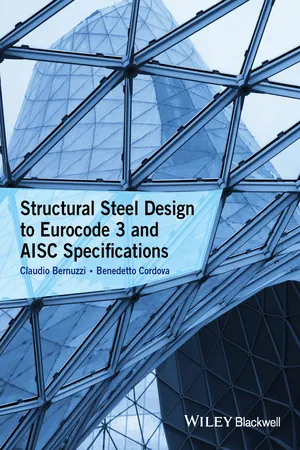
Structural Steel Design to Eurocode 3 and AISC Specifications
Claudio Bernuzzi, Benedetto Cordova
- English
- ePUB (mobile friendly)
- Available on iOS & Android
Structural Steel Design to Eurocode 3 and AISC Specifications
Claudio Bernuzzi, Benedetto Cordova
About This Book
Structural Steel Design to Eurocode 3 and AISC Specifications deals with the theory and practical applications of structural steel design in Europe and the USA. The book covers appropriate theoretical and background information, followed by a more design?oriented coverage focusing on European and United States specifications and practices, allowing the reader to directly compare the approaches and results of both codes. Chapters follow a general plan, covering: •A general section covering the relevant topics for the chapter, based on classical theory and recent research developments •A detailed section covering design and detailing to Eurocode 3 specification •A detailed section covering design and detailing to AISC specifications Fully worked examples are using both codes are presented. With construction companies working in increasingly international environments, engineers are more and more likely to encounter both codes. Written for design engineers and students of civil and structural engineering, this book will help both groups to become conversant with both code systems.
Frequently asked questions
Information
CHAPTER 1
The Steel Material
1.1 General Points about the Steel Material
- wrought iron, if the carbon content (i.e. the percentage content in terms of weight) is higher than 1.7% (some literature references have reported a value of 2%);
- steel, when the carbon content is lower than the previously mentioned limit. Furthermore, steel can be classified into extra-mild (C < 0.15%), mild (C = 0.15 ÷ 0.25%), semi-hard (C = 0.25 ÷ 0.50%), hard (C = 0.50 ÷ 0.75%) and extra-hard (C > 0.75%) materials.
- an initial branch that is mostly linear (elastic phase), in which the material shows a linear elastic behaviour approximately up to the yielding stress (fy). The strain corresponding to fy is usually indicated with εy (yielding strain). The slope of this initial branch corresponds to the modulus of elasticity of the material (also known as longitudinal modulus of elasticity or Young’s modulus), usually indicated by E, with a value between 190 000 and 210 000 N/mm2 (from 27 560 to 30 460 ksi, approximately);
- a plastic phase, which is characterized by a small or even zero slope in the σ–ε reference system;
- the ensuing branch is the hardening phase, in which the slope is considerably smaller when compared to the elastic phase, but still sufficient enough to cause an increase in stress when strain in...
Table of contents
- Cover
- Title Page
- Table of Contents
- Preface
- CHAPTER 1: The Steel Material
- CHAPTER 2: References for the Design of Steel Structures
- CHAPTER 3: Framed Systems and Methods of Analysis
- CHAPTER 4: Cross-Section Classification
- CHAPTER 5: Tension Members
- CHAPTER 6: Members in Compression
- CHAPTER 7: Beams
- CHAPTER 8: Torsion
- CHAPTER 9: Members Subjected to Flexure and Axial Force
- CHAPTER 10: Design for Combination of Compression, Flexure, Shear and Torsion
- CHAPTER 11: Web Resistance to Transverse Forces
- CHAPTER 12: Design Approaches for Frame Analysis
- CHAPTER 13: The Mechanical Fasteners
- CHAPTER 14: Welded Connections
- CHAPTER 15: Connections
- CHAPTER 16: Built-Up Compression Members
- Appendix A: Conversion Factors
- Appendix B: References and Standards
- Index
- End User License Agreement